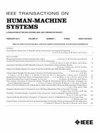Behavioral, Peripheral, and Central Neural Correlates of Augmented Reality Guidance of Manual Tasks
IF 3.5
3区 计算机科学
Q2 COMPUTER SCIENCE, ARTIFICIAL INTELLIGENCE
引用次数: 0
Abstract
Objective: The use of commercially available optical-see-through (OST) head-mounted displays (HMDs) in their own peripersonal space leads the user to experience two perception conflicts that deteriorate their performance in precision manual tasks: the vergence-accommodation conflict (VAC) and the focus rivalry. In this work, we aim characterizing for the first time the psychophysiological response associated with user's incorrect focus cues during the execution of an augmented reality (AR)-guided manual task with the Microsoft HoloLens OST-HMD. Methods: 21 subjects underwent to a “connecting-the-dots” experiment with and without the use of AR, and in both binocular and monocular conditions. For each condition, we quantified the changes in autonomic nervous system (ANS) activity of subjects by analyzing the electrodermal activity (EDA) and heart rate variability. Moreover, we analyzed the neural central correlates by means of power measures of brain activity and multivariate autoregressive measures of brain connectivity extracted from the electroencephalogram (EEG). Results: No statistically significant differences of ANS correlates were observed among tasks, although all EDA-related features varied between rest and task conditions. Conversely, significant differences among conditions were present in terms of EEG-power variations in the增强现实引导手动任务的行为、外周和中枢神经相关性
目的:在个人周围空间使用市售的光学透视(OST)头戴式显示器(HMD)会导致用户经历两种感知冲突,从而降低他们在精确手动任务中的表现:会聚-适应冲突(VAC)和焦点竞争。在这项工作中,我们旨在首次描述用户在使用微软 HoloLens OST-HMD 执行增强现实(AR)引导的手动任务时,与不正确的焦点提示相关的心理生理反应。方法:21 名受试者在使用或不使用 AR 的情况下,在双目和单目条件下进行了 "连线 "实验。在每种条件下,我们通过分析皮电活动(EDA)和心率变异性来量化受试者自律神经系统(ANS)活动的变化。此外,我们还通过大脑活动的功率测量和从脑电图(EEG)中提取的大脑连接的多变量自回归测量来分析神经中枢相关性。结果显示尽管所有与 EDA 相关的特征在休息和任务条件下均有不同,但在不同任务之间未观察到 ANS 相关因素存在统计学意义上的显著差异。相反,在 $\mu$ (8-13) Hz 和 $\beta$ (13-30) Hz 波段的脑电图功率变化方面,不同条件下存在明显差异。此外,由中央前回、楔前回和纺锤形回组成的大脑网络参与运动和眼手协调的因果相互作用也发生了重大变化。结论我们研究结果的生理学合理性表明,未来有望应用于研究更复杂的场景,如 AR 引导的外科手术。
本文章由计算机程序翻译,如有差异,请以英文原文为准。
求助全文
约1分钟内获得全文
求助全文
来源期刊

IEEE Transactions on Human-Machine Systems
COMPUTER SCIENCE, ARTIFICIAL INTELLIGENCE-COMPUTER SCIENCE, CYBERNETICS
CiteScore
7.10
自引率
11.10%
发文量
136
期刊介绍:
The scope of the IEEE Transactions on Human-Machine Systems includes the fields of human machine systems. It covers human systems and human organizational interactions including cognitive ergonomics, system test and evaluation, and human information processing concerns in systems and organizations.
 求助内容:
求助内容: 应助结果提醒方式:
应助结果提醒方式:


